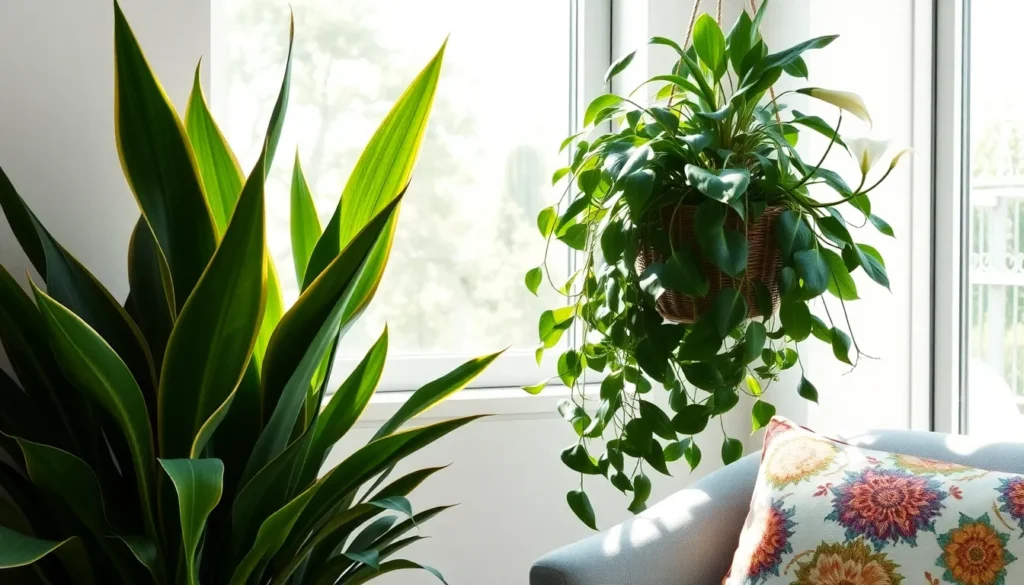We’ve all heard that houseplants can brighten up our living spaces, but did you know they’re also working hard to clean the air we breathe? NASA’s groundbreaking Clean Air Study revealed that certain plants can remove harmful toxins like formaldehyde, benzene, and trichloroethylene from our indoor environments. These natural air purifiers don’t just look beautiful – they’re actually improving our health every single day.
In our modern homes filled with synthetic materials, cleaning products, and electronic devices, indoor air quality often suffers more than we realize. The average person spends about 90% of their time indoors, making air purification more crucial than ever. While expensive air purifiers can cost hundreds of dollars, nature offers us an affordable and attractive alternative.
We’ve researched the most effective air-purifying plants that combine easy care with powerful cleaning abilities. These green heroes will transform your home into a healthier sanctuary while adding natural beauty to every room.
Snake Plant: The Ultimate Low-Maintenance Air Purifier
Snake plants (Sansevieria trifasciata) consistently rank among the most effective air purifying plants for busy homeowners. We’ve found this robust plant delivers exceptional air cleaning results while demanding virtually zero maintenance from its owners.
Removes Formaldehyde and Benzene
Formaldehyde elimination becomes effortless with snake plants working around the clock in your living spaces. NASA’s research confirms these hardy plants remove up to 107 micrograms of formaldehyde per hour from indoor environments. Benzene levels drop significantly when snake plants filter the air through their thick, sword-like leaves.
Household products like cleaning supplies, adhesives, and furniture emit these harmful chemicals continuously. Snake plants absorb these toxins through their leaf surfaces and convert them into harmless compounds. We recommend placing one medium-sized snake plant per 100 square feet of floor space for optimal air purification results. Chemical removal happens even during nighttime hours, making snake plants unique among most air purifying varieties.
Thrives in Low Light Conditions
Low light environments suit snake plants perfectly, unlike other air purifying species that demand bright indirect sunlight. Office cubicles, basement rooms, and north-facing windows provide adequate lighting for healthy snake plant growth. We’ve observed these plants maintaining their vibrant green coloration even in fluorescent-only lighting conditions.
Adaptability to various light levels makes snake plants ideal for apartments with limited natural light exposure. Direct sunlight actually stresses these plants and can cause leaf scorching or yellowing. Bathrooms, bedrooms, and interior hallways become perfect locations for snake plant placement without compromising their air cleaning abilities.
Requires Minimal Watering
Watering frequency for snake plants ranges from every 2-6 weeks, depending on environmental conditions and pot size. We suggest checking soil moisture by inserting your finger 2 inches deep before adding any water. Overwatering kills more snake plants than drought conditions ever will.
Succulent-like leaves store water efficiently, allowing snake plants to survive extended periods without irrigation. Winter months require even less frequent watering as plant growth slows and water evaporation decreases. Root rot develops quickly in soggy soil, so we always recommend well-draining potting mix and containers with drainage holes. Neglectful plant parents actually see better results with snake plants compared to attentive daily waterers.
Spider Plant: The Fast-Growing Oxygen Booster
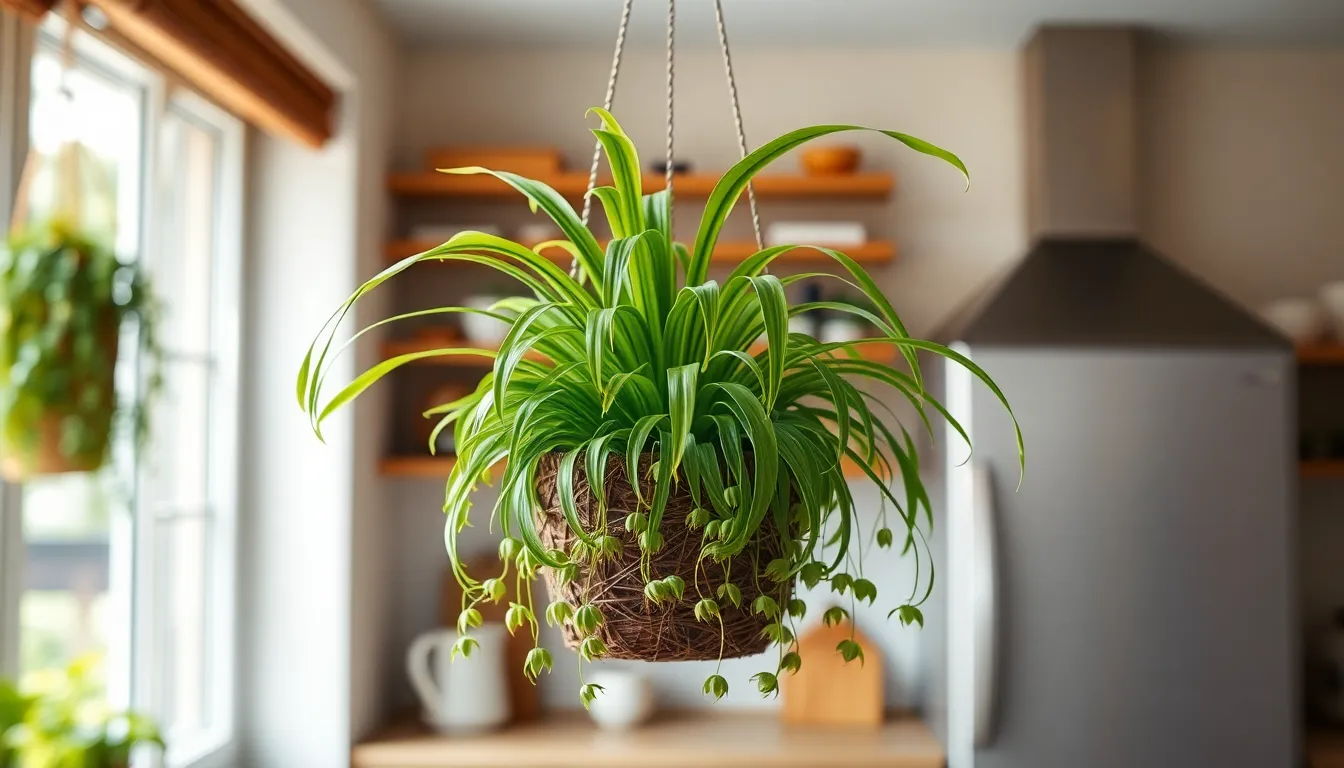
Spider plants stand out as one of nature’s most efficient air purifiers while doubling as prolific propagators. These resilient houseplants offer exceptional versatility for both novice and experienced plant enthusiasts.
Eliminates Carbon Monoxide and Xylene
Spider plants excel at removing two particularly harmful indoor pollutants that pose serious health risks. Carbon monoxide, the odorless gas that can leak from faulty appliances or poor ventilation, gets effectively filtered by these hardy plants. Xylene, commonly found in paint thinners, adhesives, and cleaning products, also gets neutralized through the spider plant’s natural purification process.
We’ve found that spider plants work continuously to cleanse indoor air, making them excellent additions to kitchens, garages, and newly painted rooms. Their ability to process these exact toxins makes them invaluable for homes with gas appliances or recent renovations. Studies show that spider plants can significantly reduce xylene concentrations within 24 hours of placement.
Produces Many Baby Plants
Spider plants create an endless supply of new plants through their unique reproductive system. These parent plants send out long, arching stems called stolons that develop small plantlets at their tips. Each mature spider plant can produce dozens of baby plants throughout the growing season.
We recommend allowing the plantlets to develop roots while still attached to the mother plant before separating them. This natural propagation method means you’ll never need to purchase another spider plant again. The baby plants can be shared with friends, placed throughout your home, or used to replace aging parent plants.
Perfect for Hanging Baskets
Spider plants’ cascading growth pattern makes them ideal candidates for elevated displays. Their long, arching leaves and dangling plantlets create stunning visual displays when housed in hanging containers. We’ve discovered that hanging baskets allow spider plants to showcase their full natural beauty while maximizing their air purifying coverage area.
Elevated placement also prevents pets and children from accessing the plants while ensuring optimal light distribution. The trailing stems with baby plants create living curtains that add natural elegance to any room. Spider plants in hanging baskets require the same minimal care as their potted counterparts but offer enhanced decorative appeal.
Peace Lily: The Elegant Toxin Fighter
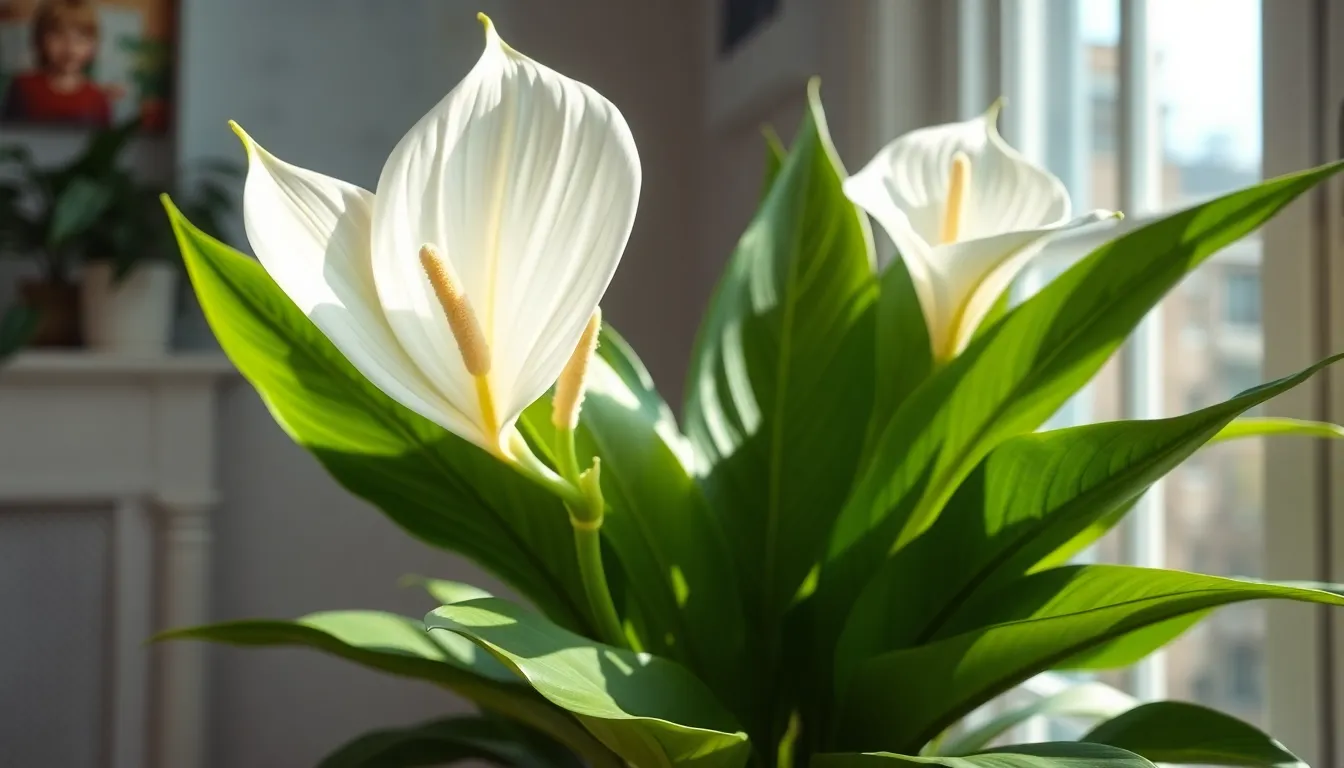
Peace lilies stand out as exceptional indoor air purifiers that combine functionality with stunning visual appeal. We’ve found them to be particularly effective at targeting exact household toxins while maintaining their reputation as low-maintenance houseplants.
Filters Out Ammonia and Acetone
Peace lilies excel at removing ammonia and acetone from indoor air, making them powerful allies against common household pollutants. These plants effectively filter out seven major toxins including benzene, formaldehyde, trichloroethylene, xylene, and toluene alongside their specialty targets. NASA’s Clean Air Study recognizes peace lilies as one of the most effective plants for improving indoor air quality.
Ammonia typically enters our homes through cleaning products, fertilizers, and tobacco smoke, while acetone comes from nail polish removers, paint thinners, and certain plastics. Peace lilies work continuously to absorb these harmful chemicals through their leaves and roots, converting them into harmless compounds. We recommend placing these plants in areas where chemical exposure is highest, such as bathrooms with cleaning supplies or home offices with printing equipment.
Features Beautiful White Blooms
Peace lilies produce elegant white flowers that serve dual purposes as air purifiers and decorative elements. Their distinctive white blooms, which are actually specialized leaves called spathes, create striking focal points in any room while working to clean the air. These flowers can last for several weeks, providing extended periods of both beauty and enhanced air purification.
The blooming cycle typically occurs once or twice per year when plants receive proper care and adequate light conditions. We’ve observed that healthy peace lilies in optimal environments may produce multiple blooms throughout the growing season. Each flower contributes to the plant’s overall air-cleaning capacity, making blooming peace lilies particularly valuable for indoor air quality improvement.
Indicates Watering Needs Through Drooping
Peace lilies communicate their watering requirements through visible leaf drooping, eliminating guesswork from plant care routines. When these plants need water, their leaves dramatically wilt and hang downward, providing an unmistakable signal that it’s time to water. This natural indicator system makes peace lilies ideal for both experienced gardeners and beginners.
We’ve found that peace lilies require less frequent watering compared to many other houseplants, typically needing water every 1-2 weeks depending on environmental conditions. They prefer temperatures between 16°C and 32°C and thrive in indirect light or artificial lighting conditions. After watering, the leaves perk up within hours, confirming that the plant has received adequate moisture for continued air purification performance.
Rubber Plant: The Formaldehyde Elimination Expert

The rubber plant stands out as a powerhouse for removing formaldehyde from indoor air. We’ve found this versatile houseplant excels at targeting one of the most common indoor pollutants while offering impressive visual appeal.
Targets Airborne Chemicals Effectively
Formaldehyde removal becomes the rubber plant’s specialty, making it particularly valuable in homes with new furniture or carpeting. This toxic chemical commonly enters our living spaces through pressed wood products, adhesives, and synthetic materials. Rubber plants actively filter these harmful compounds from the air we breathe daily.
Indoor air quality improves significantly when we place rubber plants in areas with high formaldehyde concentrations. Studies show these plants consistently remove this dangerous pollutant more effectively than many other houseplant varieties. Chemical emissions from household products get neutralized through the plant’s natural filtration system.
Grows Into an Impressive Indoor Tree
Size potential sets rubber plants apart from smaller air purifying options we’ve discussed. These plants can reach impressive heights indoors, transforming from small potted specimens into stunning tree-like features. Growth patterns allow them to become focal points that purify air while serving as living sculptures.
Space requirements remain manageable even though their potential size, making rubber plants suitable for various room configurations. We can easily control their growth through pruning and pot size selection. Indoor environments provide the perfect conditions for these plants to develop their characteristic broad, glossy leaves.
Adapts to Various Light Conditions
Light flexibility makes rubber plants ideal for different indoor locations throughout our homes. These plants tolerate dim light conditions while also thriving in brighter spots with filtered sunlight. Direct sunlight can cause leaf burn, so we recommend positioning them near windows with morning light exposure.
Watering schedules become simple with rubber plants requiring moisture every 1-2 weeks depending on environmental conditions. Cooler temperatures don’t stress these hardy plants, making them perfect for offices or rooms with variable heating. Filtered morning sunlight provides optimal growing conditions when available in our indoor spaces.
Boston Fern: The Natural Humidity Controller

Boston ferns stand out among air purifying plants for their dual ability to clean the air while naturally regulating indoor humidity levels. We’ll explore how these lush plants transform your living space into a healthier environment.
Removes Formaldehyde and Xylene
Boston ferns effectively target two major indoor air pollutants that commonly affect our homes. Formaldehyde removal happens through the plant’s natural filtration system, making it particularly valuable in spaces with new furniture or carpeting. Xylene elimination occurs simultaneously, addressing chemicals released from paints, adhesives, and household cleaning products.
NASA’s Clean Air Study recognizes Boston ferns for their ability to process these harmful compounds through their extensive frond system. The plant’s large surface area allows for maximum pollutant absorption throughout the day. Regular air purification continues as long as the fern remains healthy and properly maintained.
Adds Moisture to Dry Indoor Air
Boston ferns naturally release moisture through a process called transpiration, increasing humidity levels in dry indoor environments. We recommend placing these plants in rooms where heating systems or air conditioning create overly dry conditions. Moisture release happens continuously, providing consistent humidity regulation without the need for electric humidifiers.
Indoor humidity levels can increase by 5-10% with strategically placed Boston ferns throughout your home. The plant’s moisture output helps alleviate dry skin, respiratory irritation, and static electricity common in low humidity environments. Natural humidity control works best when you maintain proper soil moisture and provide adequate indirect light.
Creates Lush, Tropical Atmosphere
Boston ferns transform any space with their cascading, feathery fronds that create an instant tropical ambiance. We love how these plants add visual depth and texture to corners, hanging baskets, or plant stands throughout the home. Their vibrant green foliage brings life to bathrooms, living rooms, and covered porches year round.
Bright, indirect light keeps Boston ferns looking their most lush and full. Consistent moisture requirements mean you’ll need to water when the soil feels slightly dry to the touch. The plant’s natural growth pattern creates a stunning focal point while continuously working to improve your indoor air quality and comfort levels.
Aloe Vera: The Multi-Purpose Air Cleaner
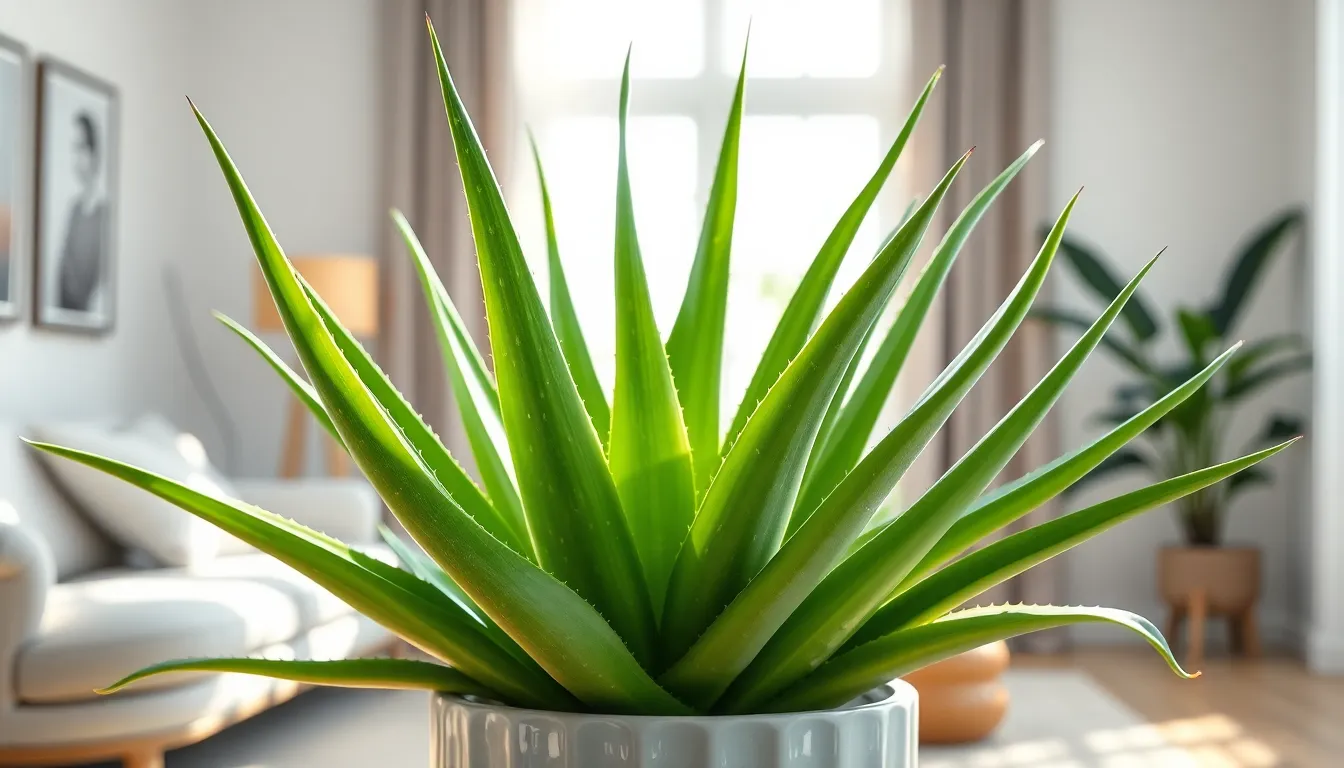
While other plants excel at removing exact airborne toxins, aloe vera offers unique benefits that extend beyond traditional air purification.
Absorbs Carbon Dioxide at Night
Unlike most plants that absorb carbon dioxide during daylight hours, aloe vera continues this process throughout the night. This nocturnal carbon dioxide absorption helps maintain cleaner indoor air while we sleep. Bedrooms benefit significantly from this nighttime air cleaning action, as aloe vera plants work continuously to reduce carbon dioxide levels. CAM photosynthesis allows aloe vera to open its stomata after dark, making it an ideal bedroom companion for improved overnight air quality.
Provides Healing Gel for Skin
Beyond air purification capabilities, aloe vera plants contain medicinal gel within their thick, succulent leaves. This healing gel provides immediate relief for minor burns, cuts, and skin irritations when applied directly from fresh leaves. First aid treatments become readily available with aloe vera plants positioned throughout the home. Natural compounds like acemannan and aloesin within the gel promote faster healing and reduce inflammation. Sunburn relief happens almost instantly when fresh aloe gel is applied to affected skin areas.
Requires Minimal Care and Attention
Aloe vera plants thrive with minimal maintenance, making them perfect for busy households or beginner plant parents. Watering needs remain low, typically requiring water only every 2-3 weeks during growing seasons. Drought tolerance allows aloe vera to survive extended periods without attention, unlike more demanding houseplants. Bright, indirect sunlight provides optimal growing conditions, though these resilient plants adapt to various light levels. Well-draining soil prevents root rot, and standard potting mix works perfectly for healthy growth.
English Ivy: The Mold-Fighting Champion
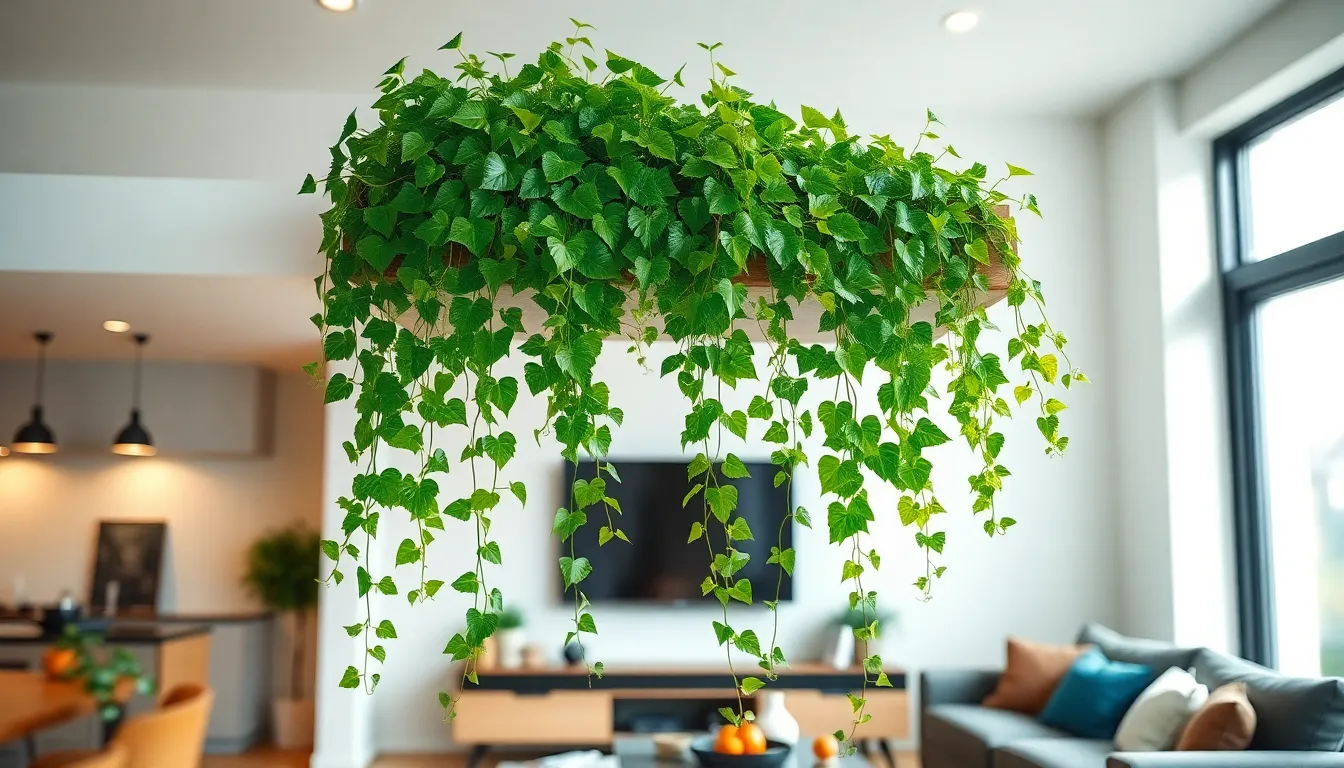
English ivy stands out among air purifying plants for its unique ability to combat airborne mold while adding natural beauty to your living space.
Reduces Airborne Mold Particles
Reduces Airborne Mold Particles more effectively than most houseplants, making English ivy an exceptional choice for improving indoor air quality. Studies show this remarkable plant can significantly decrease mold spores floating in your home’s atmosphere within hours of placement. Bathrooms, basements, and other moisture-prone areas benefit tremendously from English ivy’s mold-fighting capabilities.
Purifies the air by removing harmful pollutants beyond just mold, including benzene, formaldehyde, and other toxic compounds commonly found in household products. NASA research confirms English ivy’s effectiveness at filtering multiple air contaminants simultaneously. We recommend placing English ivy in areas where humidity levels tend to be higher for maximum mold reduction benefits.
Trails Beautifully from Shelves
Trails Beautifully from Shelves with cascading vines that create stunning visual displays while continuously purifying your air. English ivy’s graceful draping habit makes it perfect for high shelves, bookcases, and hanging planters where its vines can flow naturally downward. Your home gains both aesthetic appeal and cleaner air through this plant’s elegant growth pattern.
Grows in attractive trailing formations that complement any interior design style, from modern minimalist to traditional decor schemes. Each vine develops multiple leaves that work together to maximize air purification surface area. We’ve found that placing English ivy on tall furniture creates dramatic green waterfalls that serve as living art pieces.
Grows Rapidly with Proper Care
Grows Rapidly with Proper Care and can quickly establish substantial air purifying coverage throughout your living space. English ivy responds well to consistent watering schedules and bright, indirect light conditions. Within weeks of proper placement, you’ll notice important vine growth that translates to enhanced air cleaning capacity.
Develops extensive coverage when provided with adequate moisture and filtered sunlight, allowing a single plant to purify air across larger room areas. Regular pruning encourages bushier growth and prevents the plant from becoming leggy or sparse. We suggest monitoring soil moisture levels weekly and providing support structures if you want to train the vines in exact directions.
Bamboo Palm: The Tropical Air Scrubber
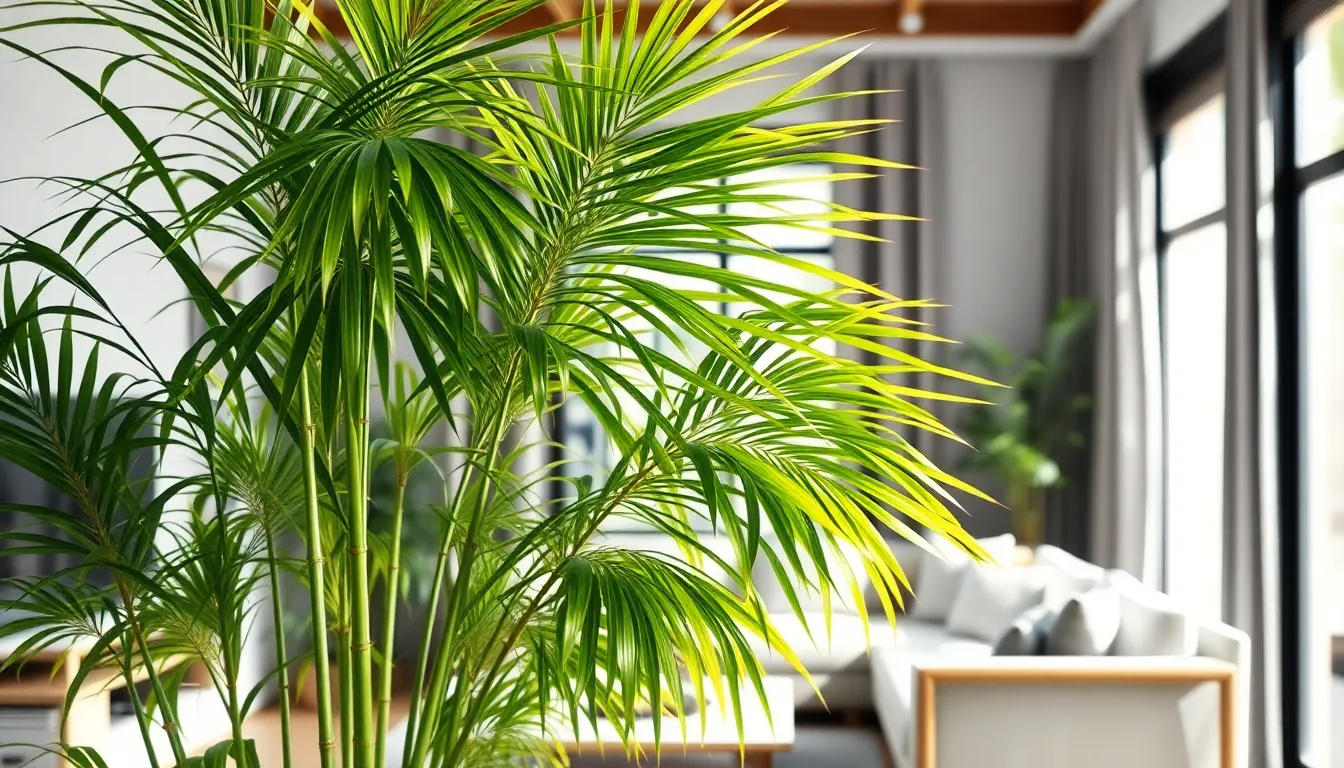
The bamboo palm stands out as one of our most effective natural air purifiers while bringing an exotic touch to indoor spaces. This remarkable plant excels at removing exact harmful chemicals that commonly contaminate our homes.
Eliminates Benzene and Trichloroethylene
Bamboo palms specifically target two dangerous chemicals that lurk in many household items. Benzene exposure comes from synthetic fibers, plastics, rubber, and cleaning products found throughout our homes. Trichloroethylene appears in adhesives, spot removers, and paint strippers that we often use for home maintenance projects.
These palms actively filter these toxins from our indoor air through their extensive leaf system. Their natural purification process works continuously, making them particularly valuable in garages, basements, or workshops where chemical exposure tends to be higher. We can place multiple bamboo palms throughout our homes to create a comprehensive air cleaning network.
Adds Exotic Appeal to Any Room
Bamboo palms bring an instant tropical atmosphere to any indoor environment with their graceful fronds and elegant silhouette. Their feathery leaves create beautiful shadows and movement, adding visual interest to corners, living rooms, or office spaces. These plants can grow several feet tall indoors, making them perfect statement pieces that command attention.
Their lush green foliage complements both modern and traditional decor styles seamlessly. We love how bamboo palms soften harsh architectural lines while creating natural focal points in our rooms. Their upright growth pattern makes them ideal for filling empty corners or flanking doorways.
Grows Well in Indirect Sunlight
Bamboo palms thrive in bright, indirect light conditions that make them perfect for most indoor locations. They adapt well to north or east facing windows where harsh direct sunlight won’t scorch their delicate fronds. These adaptable plants also tolerate lower light conditions, though their growth may slow slightly.
We recommend keeping bamboo palms about 6 feet away from south facing windows to prevent leaf burn. Their preference for filtered light makes them excellent choices for offices with fluorescent lighting or homes with limited natural light. Regular misting helps maintain the humidity levels these tropical natives prefer, especially during dry winter months.
Pothos: The Versatile Pollutant Remover

We’ve discovered that pothos (Epipremnum aureum) stands out as one of nature’s most adaptable air purifiers. This remarkable plant combines exceptional pollutant removal with unmatched growing flexibility.
Clears Formaldehyde from Indoor Air
Pothos effectively targets formaldehyde, one of the most common indoor pollutants we encounter daily. This toxic compound lurks in household items like furniture, carpeting, and cleaning products, making our indoor air potentially harmful. Formaldehyde removal happens through the plant’s leaves and root system, which continuously filter this dangerous chemical from our breathing space.
We’ll find pothos particularly valuable in newly furnished homes where formaldehyde levels tend to spike. The plant’s air cleansing abilities work around the clock, steadily reducing contamination levels in our living spaces. Studies confirm that pothos ranks among the top performers for formaldehyde elimination, making it an essential addition to our indoor air purification strategy.
Thrives in Water or Soil
Water propagation makes pothos incredibly versatile for our growing preferences and space constraints. We can simply place cuttings in a glass of water and watch roots develop within weeks. This flexibility allows us to display pothos in decorative vases, mason jars, or specialized hydroponic containers throughout our homes.
Soil cultivation offers equally impressive results for those who prefer traditional potting methods. The plant adapts seamlessly to standard potting mix, requiring minimal care while delivering maximum air purification benefits. We’ll discover that pothos tolerates various growing conditions, from bright indirect light to lower light situations that challenge other houseplants.
Features Heart-Shaped Leaves
Heart shaped foliage creates visual appeal that complements pothos’ air cleaning capabilities perfectly. These distinctive leaves cascade beautifully from hanging baskets or climb elegantly up moss poles, adding natural beauty to any room. We’ll notice how the glossy green surface maximizes the plant’s ability to absorb airborne toxins while creating an attractive focal point.
Variegated varieties offer additional aesthetic options with cream, white, or yellow markings that brighten darker spaces. The leaves’ broad surface area increases formaldehyde absorption capacity, making each plant more effective at cleaning our indoor air. This combination of function and beauty makes pothos an ideal choice for rooms where we want both cleaner air and enhanced decor.
Chrysanthemum: The Colorful Chemical Filter
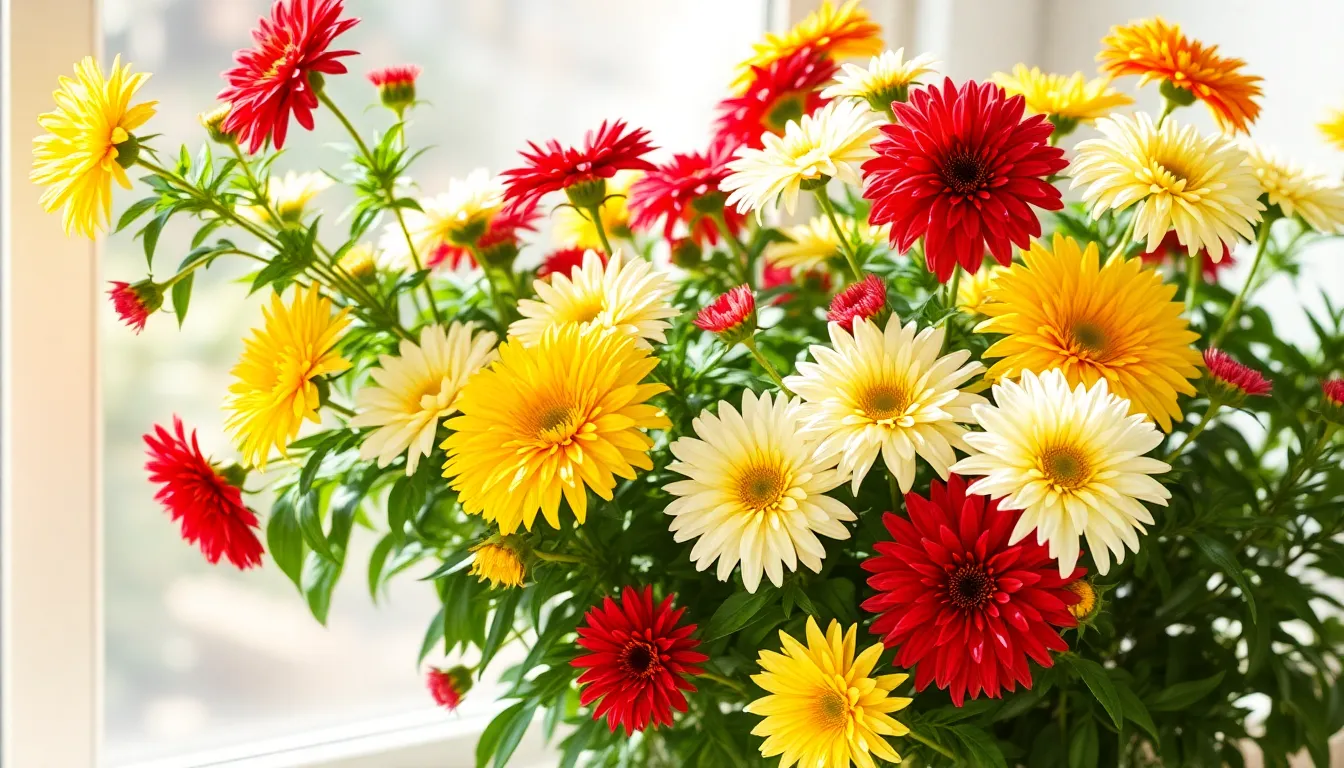
Chrysanthemums bring vibrant beauty to your air purification efforts while tackling some of the most stubborn indoor toxins. These flowering powerhouses combine aesthetic appeal with serious chemical filtering capabilities.
Removes Benzene and Ammonia
Chrysanthemums excel at eliminating benzene, formaldehyde, trichloroethylene, ammonia, xylene, and toluene from indoor air. Their impressive chemical removal range makes them particularly valuable in spaces with multiple pollutant sources like home offices or create rooms. Studies show these plants can significantly reduce harmful chemical concentrations within hours of placement.
Benzene removal capabilities make chrysanthemums especially useful near computers and electronics where this toxic compound commonly accumulates. Ammonia filtering abilities prove invaluable in bathrooms and areas exposed to cleaning products. We’ve found their multi toxin approach sets them apart from plants that target only one or two exact chemicals.
Blooms in Various Bright Colors
Brilliant blooms transform any space while simultaneously purifying the air around them. Chrysanthemums produce flowers in vibrant yellows, deep reds, pure whites, and rich purples that last for weeks when properly maintained. Their colorful displays create natural focal points that enhance home decor while working continuously to clean indoor air.
Different varieties offer unique flower shapes from traditional daisy like petals to full pompom styles. Color combinations within single plants provide visual interest that changes throughout the blooming season. We recommend selecting varieties that complement your existing color scheme while maximizing air purification benefits.
Works Best Near Windows
Bright sunlight exposure maximizes both flowering potential and air cleaning efficiency in chrysanthemums. These plants thrive when placed within three feet of south facing or west facing windows where they receive at least six hours of direct sunlight daily. Full sun conditions trigger optimal chemical absorption rates while promoting healthy bloom development.
Temperature tolerance between 5 to 45 degrees Celsius allows chrysanthemums to flourish near windows year round in most climates. Window placement also ensures proper air circulation around the plant for maximum pollutant filtering. We suggest rotating plants weekly to ensure even light distribution and prevent leggy growth patterns that reduce air purification effectiveness.
Conclusion
We’ve explored nature’s most powerful air purifiers that can transform your indoor environment while adding beauty to your space. From the low-maintenance snake plant to the humidity-regulating Boston fern these green allies work tirelessly to remove harmful toxins from your home.
The best part? You don’t need to choose just one. Mix and match different plants throughout your living spaces to create a comprehensive air purification system that’s both effective and visually stunning.
Start small with one or two plants that match your care preferences and lighting conditions. As you gain confidence you can expand your collection and enjoy cleaner air healthier living and the satisfaction of nurturing these natural air cleaners.
Your lungs and your home will thank you for making this simple yet impactful change.
Frequently Asked Questions
What are the main benefits of air-purifying houseplants?
Air-purifying houseplants offer multiple benefits beyond decoration. They remove harmful toxins like formaldehyde, benzene, and trichloroethylene from indoor air, as confirmed by NASA’s Clean Air Study. Since people spend 90% of their time indoors, these plants provide an affordable alternative to expensive air purifiers while improving overall health and air quality.
Which houseplant is best for beginners who want air purification?
The snake plant (Sansevieria trifasciata) is ideal for beginners. It requires minimal care, thrives in low light conditions, and only needs watering every 2-6 weeks. Despite its low maintenance needs, it effectively removes formaldehyde and benzene from indoor air, making it perfect for busy households or those new to plant care.
How many snake plants do I need for effective air purification?
For optimal air purification results, place one medium-sized snake plant per 100 square feet of indoor space. Snake plants can remove up to 107 micrograms of formaldehyde per hour and significantly reduce benzene levels, making them highly efficient natural air filters for homes and offices.
What makes spider plants unique for air purification?
Spider plants excel at removing carbon monoxide and xylene from indoor air, particularly valuable in kitchens and garages. They can significantly reduce xylene concentrations within 24 hours. Additionally, spider plants produce numerous baby plants for easy propagation, and their cascading growth pattern makes them perfect for hanging baskets while maximizing air purification.
Where should I place peace lilies for maximum air purification benefits?
Place peace lilies in areas with high chemical exposure, such as bathrooms and home offices. They effectively target ammonia and acetone, plus other major pollutants. Peace lilies thrive in indirect light and indicate their watering needs through drooping leaves, requiring water every 1-2 weeks while producing beautiful white blooms.
Why are rubber plants recommended for homes with new furniture?
Rubber plants excel at eliminating formaldehyde, which is commonly released by new furniture and carpeting. They effectively filter harmful airborne chemicals and can grow into impressive indoor trees, serving as both air purifiers and decorative focal points. They adapt well to various light conditions and need watering every 1-2 weeks.
How do Boston ferns help with both air quality and humidity?
Boston ferns remove formaldehyde and xylene while releasing moisture through transpiration, naturally increasing indoor humidity levels. This dual function helps alleviate dry skin and respiratory irritation in dry environments. Their extensive frond system maximizes pollutant absorption, and they thrive in bright, indirect light with consistent moisture.
What makes aloe vera special for bedroom air purification?
Unlike most plants, aloe vera absorbs carbon dioxide at night, making it perfect for bedrooms. It maintains cleaner air while you sleep and offers the added benefit of healing gel for minor burns and skin irritations. Aloe vera requires minimal care, needing water only every 2-3 weeks.
Where is English ivy most effective for air purification?
English ivy works best in moisture-prone areas like bathrooms and basements where it combats airborne mold while removing benzene and formaldehyde. It can significantly reduce mold spores within hours of placement. The cascading vines maximize air purification surface area while adding aesthetic appeal to living spaces.
What chemicals do bamboo palms target most effectively?
Bamboo palms specifically target benzene and trichloroethylene, chemicals commonly found in household items. They’re particularly valuable in areas with higher chemical exposure, such as garages and workshops. Their extensive leaf system filters these toxins while adding an exotic touch with graceful fronds and elegant silhouette.
Can pothos grow in water instead of soil?
Yes, pothos can thrive in both water and soil, making it highly versatile for different growing preferences. This adaptability, combined with its effectiveness at removing formaldehyde, makes it ideal for newly furnished homes. The heart-shaped leaves maximize air-cleaning capabilities while providing attractive variegated varieties for enhanced decor.
What makes chrysanthemums unique among air-purifying plants?
Chrysanthemums remove the widest range of indoor toxins, including benzene, formaldehyde, trichloroethylene, ammonia, xylene, and toluene. This makes them particularly valuable in spaces with multiple pollutant sources. They require bright sunlight and are best placed near windows to maximize their air-cleaning efficiency while providing colorful blooms.

